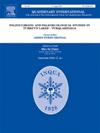Changes in the magnitude and frequency of Holocene monsoon floods on the Mahi River, western India with special reference to Anthropocene
IF 1.8
3区 地球科学
Q3 GEOGRAPHY, PHYSICAL
引用次数: 0
Abstract
Over the past seven decades, the monsoon-dominated Mahi River in western India has experienced extraordinarily large floods, ranking among the highest recorded rainfall-runoff discharges per drainage area in the world. The large magnitude floods on this river are direct outcomes of severe tropical cyclones/storms implanted within the Indian summer monsoon. The cluster of extreme floods in the past few decades represents an inconsistent strengthening in both the magnitude and frequency of large floods when compared with the 17 ka record of palaeoflood deposits in the basin. Palaeoflood records have been reconstructed from high-water marks (scour line, shrub line, trimline) and palaeostage indicators such as slackwater deposit (flood deposit benches, eddy bars, and deposits at tributary mouths). An investigation of relative magnitude for modern, historical and palaeofloods shows that the present and second half of the last century is characterized by very large magnitude floods. The study demonstrates that most historical floods and palaeofloods, for which there is evidence, were smaller in magnitude compared to modern floods. The examination further reveals that the floods are clustered in distinct time intervals. There is evidence of clustering in five different periods - (a) 9000 - 7000 BCE, (b) 3000 - 0 BCE, (c) between 1520s and 1720s, (d) Aaround 1920s, and (e) between 1960s and 1990s. The largest floods in the modern record of the Mahi River at the Wanakbori site between the 1960s and 2020s is 120-yr flood, while its tributary, the Som River at the Rangeli site, is 720-yr flood according to the Log-Pearson III probability distribution. A comparison between palaeofloods and gauged record demonstrating the enormous recent increase in the magnitude and frequency of severe floods. This cluster of severe floods from the current and last century could be due to changes in climate, land use, or the construction of dams, thereby indicating the influence of human activity. These post-1950 CE floods are thus the largest at least in the Holocene. Numerous palaeoflood studies in tropical storm regions reveal a similar increase in high-magnitude floods within the past seven decades. This pattern suggests that widespread climatic changes, land use modifications, and the construction of large dams are contributing factors, indicating an increase in the magnitude and frequency of floods during the Anthropocene.
印度西部Mahi河全新世季风洪水的震级和频率变化与人类世的特殊关系
在过去的70年里,印度西部受季风支配的Mahi河经历了特大洪水,是世界上每个流域降雨量最高的地区之一。这条河上的大洪水是在印度夏季季风中植入的强烈热带气旋/风暴的直接结果。与17 ka古洪水沉积记录相比,过去几十年的极端洪水集群表现出大洪水的强度和频率不一致的增强。古洪水记录由高水位标志(冲刷线、灌木线、边线)和淡水沉积(洪积滩、涡坝和支流河口沉积)等古阶段标志重建。对现代、历史和古洪水的相对震级的调查表明,上个世纪的现在和下半叶以特大洪水为特征。研究表明,有证据表明,历史上大多数洪水和古洪水的规模都小于现代洪水。进一步的研究表明,洪水在不同的时间间隔内聚集。有证据表明,在五个不同时期(a)公元前9000 - 7000年,(b)公元前3000 - 0年,(c) 1520年代至1720年代,(d) 20世纪20年代左右,(e) 20世纪60年代至90年代。根据Log-Pearson III概率分布,Mahi河在Wanakbori遗址的现代记录中,20世纪60年代至20世纪20年代的最大洪水是120年的洪水,而其支流Som河在Rangeli遗址的洪水是720年的洪水。古洪水和测量记录之间的比较表明,最近严重洪水的规模和频率都大幅增加。本世纪和上个世纪发生的这一系列严重洪水可能是由于气候变化、土地利用或水坝建设造成的,从而表明了人类活动的影响。因此,这些1950年后的洪水至少在全新世是最大的。在热带风暴地区进行的大量古洪水研究表明,在过去70年里,高强度洪水也有类似的增加。这种模式表明,广泛的气候变化、土地利用的改变和大型水坝的建设是促成因素,表明在人类世期间洪水的强度和频率都有所增加。
本文章由计算机程序翻译,如有差异,请以英文原文为准。
求助全文
约1分钟内获得全文
求助全文
来源期刊

Quaternary International
地学-地球科学综合
CiteScore
5.60
自引率
4.50%
发文量
336
审稿时长
3 months
期刊介绍:
Quaternary International is the official journal of the International Union for Quaternary Research. The objectives are to publish a high quality scientific journal under the auspices of the premier Quaternary association that reflects the interdisciplinary nature of INQUA and records recent advances in Quaternary science that appeal to a wide audience.
This series will encompass all the full spectrum of the physical and natural sciences that are commonly employed in solving Quaternary problems. The policy is to publish peer refereed collected research papers from symposia, workshops and meetings sponsored by INQUA. In addition, other organizations may request publication of their collected works pertaining to the Quaternary.
 求助内容:
求助内容: 应助结果提醒方式:
应助结果提醒方式:


